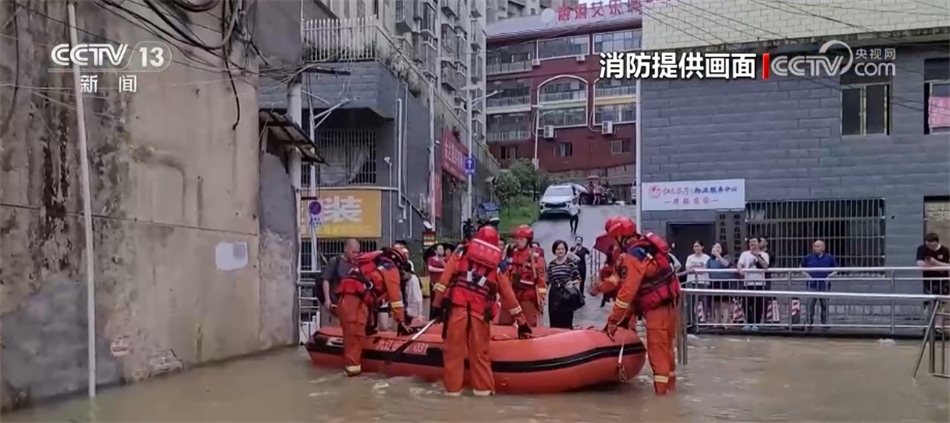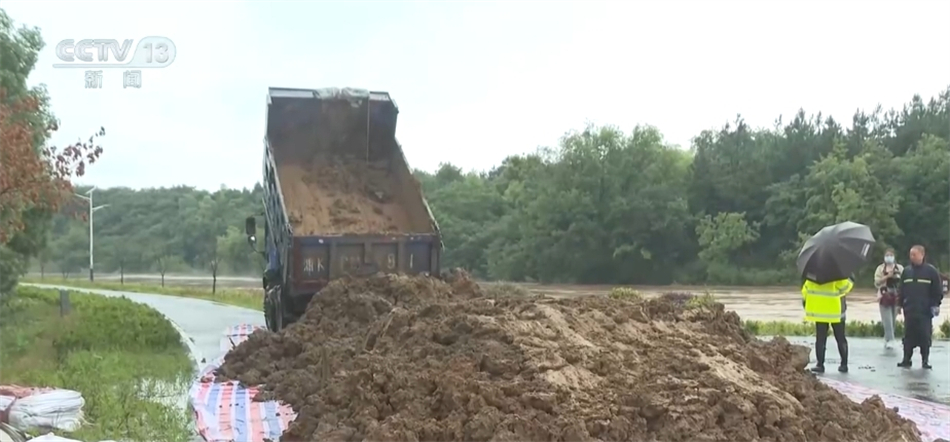Emergency transfer of the masses, emergency repairs, rushing to ensure smooth traffic … The middle and lower reaches of the Yangtze River race against time and unite as one to prevent floods.
CCTV News:On the afternoon of July 1, Jingzhou, Hubei Province issued a red rainstorm warning. Heavy rainfall caused some roads in Jingzhou City to accumulate water, and farmland and levees in Shishou, Honghu and other counties and cities were threatened. Relevant local departments at all levels took measures to actively respond.
During the day on the 1st, the urban area of Jingzhou City suffered from heavy rainfall, and the accumulated rainfall in three hours exceeded 100 mm. The precipitation caused water accumulation in some low-lying sections of the urban area, with the deepest part exceeding 10 cm. The local traffic police quickly dispatched to guide passing vehicles in the stagnant water section, and the urban emergency departments also dispatched vehicles and personnel in time for emergency drainage.

The continuous rainstorm has caused some sub-dikes of Tianxing Lake in Shishou City to overflow, and nearly 40,000 mu of farmland and some houses are at risk of being flooded. For this reason, rescuers urgently put a large-diameter pumping pipeline into the lake, first pumping the lake water to the decompression cofferdam next to it, and then opening the gate to discharge the water to the Yangtze River after the water level of the decompression cofferdam forms a gap with the water level of the Yangtze River.

In addition, affected by heavy rainfall and upstream water, the water level of the Yangtze River embankment in Honghu, Jingzhou continued to rise rapidly. At 8 o’clock on the 1 ST, the water level of the Yangtze River Luoshan Station was 32.07 meters, exceeding the warning level of 0.07 meters. The local authorities quickly organized the cadres and masses in party member to be on duty on the embankment, and carried out patrol inspection on the embankment.
Honghu Lake, Hubei Province: Heavy rainfall caused agricultural damage, and the local area quickly rescued and provided disaster relief.
Recently, heavy rainfall caused serious water accumulation in many areas of honghu city, Hubei Province, which affected agricultural production. The local area quickly organized personnel to resist floods and ensure production.
In Crystal Village, Chahe Town, honghu city, nearly 40 acres of fish ponds have been flooded due to heavy rainfall in recent days. After learning about the disaster situation of farmers, the local authorities quickly organized personnel to help farmers build dams and insert nets to reduce losses.

In Group 8 of Crystal Village, dozens of acres of rice seedlings were flooded, and nearly 100 acres of soybeans were soaked in water. The local cadres in party member and all the staff of the resident working group went out to try their best to help farmers reduce their losses. In order to ensure agricultural production, Crystal Village devoted manpower and mechanical equipment to rescue and reduce farmers’ losses.
Pingjiang, Hunan: Race against Time Pingjiang Fire Rescue Evacuate the Trapped People
There was a heavy rain in Pingjiang County. The flood has flooded into the county seat, and one-third of the urban area was flooded, with the maximum depth of 3 meters. At the same time, it caused a large-scale power outage, and some residents were trapped at home. The situation was urgent and the fire forces continued to rescue.
At 6 o’clock on July 1st, the fire rescue team in Pingjiang County mobilized all its strength to form four flood control and flood fighting commandos, driving assault boats and rubber boats to various directions in the city to race against time to transport trapped residents.

Near the Baifu Tunnel, a pregnant woman was expected to give birth ahead of schedule and anxiously waited for her to rush to the hospital. After several twists and turns, the firefighters who arrived successfully sent the pregnant woman to the county people’s hospital.

In Kangle Village, rescuers heard the baby crying in a residential building. They jumped into the water 1.5 meters deep and transferred the baby out.
In the north of the city, the assault boat came to the window of the stairwell, and the building was full of residents waiting in line for transfer.

Three firefighters and rescuers set up a "ladder" to take the trapped residents on board.
Xinshao, Hunan Province: More than 40 households with potential safety hazards were transferred due to mountain torrents.
At about 9: 00 pm on July 1, Niu Shan Village, Longxipu Town, Xinshao County, Hunan Province, experienced heavy rainfall and sudden flash floods. Niu Shan Pucun is located in the depths of the mountains, and more than 120 villagers are mostly left-behind elderly people. In order to avoid being trapped, the village quickly organized personnel, knocked on the door from door to door in groups, and transferred more than 40 villagers with potential safety hazards to safety in time. Subsequently, the local highway department rushed to the scene to repair the damaged road. At present, the road has resumed traffic.
Jiujiang, Jiangxi: Flooding of roads and houses caused by heavy rainfall, fire fighting and relocation of trapped residents.
On the afternoon of July 1st, xiushui county, Jiujiang City, Jiangxi Province issued an orange rainstorm warning signal, and the river and water repair station exceeded the police by 2.9 meters. Continuous heavy rainfall caused waterlogging in the local area, some roads and houses were flooded, and some residents were trapped at home. The fire department quickly organized forces to rescue the trapped residents.
At 6: 00 pm on the 1st, in Yining Town, xiushui county, the local flooded road section was 2 kilometers long, and there was water on the first floor of shops and residential buildings along the street, with the water depth reaching about 1.5 meters. Firefighters drove assault boats and moved trapped people from house to house. In front of a residential building with deep water, a mother and daughter were blocked by the water because the corridor was too narrow. Fire and rescue workers waded into the building, first carried the little girl, then carried her mother to the assault boat, and then transported them to safety.

In front of another residential building, firemen took the infant from a mother in the stagnant water submerged to the thigh. In order to avoid getting wet, firemen held the baby in their hands and carefully moved it outward. Finally, with the help of teammates, all the trapped residents were safely transferred.

In addition, the accumulated water also prevented some residents from going home. Firefighters used rubber boats as "ferry boats" to walk through the water and pick up residents to return home safely.

In Huamen Village, Shi ‘ao Township, xiushui county, on the afternoon of the 1st, the main road leading to the village was flooded by the rushing water, and the water level continued to rise. Firefighters learned that an elderly man in his seventies in the village was unable to move alone at home, and immediately formed a rescue team to come to the old man. After asking about the physical condition of the old man, they decided to carry him out with the seat and transfer him to a safe place.

Considering that there will still be precipitation in the next two days, the local authorities are organizing forces to inspect and eliminate risks to prevent secondary disasters.
Jiujiang, Jiangxi: The water level of Xiuhe River exceeds the warning level of 2.9 meters, and the local people are urgently transferred.
On July 1, affected by continuous heavy rainfall and upstream water, the water level of Jiangxi Xiuhe Xiushui Station exceeded the warning level of 2.9 meters, which caused many houses in Ningzhou Town to be flooded and the people were trapped. Local party member cadres and several rescue forces rushed to the scene at the first time to transfer the trapped people.

At 5 o’clock in the afternoon on the 1 ST, affected by heavy rainfall and upstream water, the water level of Xiuhe River rose rapidly. In Nanya Community and Wenfeng Community in Ningzhou Town, xiushui county, many street houses were flooded, and the deepest part of the water was about 1.5 meters. A large number of people were trapped. Local party member cadres and several rescue forces used assault boats to transfer the trapped people to safe areas in batches. By the afternoon of July 1st, more than 2,000 trapped people had been successfully transferred in this area, and the local people were given stable accommodation by visiting relatives and friends and centralized resettlement.
Yichun, Jiangxi Province: The landslide of provincial and county roads is blocked, and it is raining to repair and rush to ensure smooth traffic.
Recently, due to the continuous rainfall, many roads in Yifeng County, Jiangxi Province have experienced landslides and collapses, and the local authorities quickly organized forces to carry out emergency repairs in the rain.
At about 17: 00 on June 30, a large area of landslide and collapse occurred in the section of Daokuqian Village in 573 County due to heavy rain, and a large number of rocks and trees fell, blocking traffic and blocking villagers’ access.

In order to grab the access road as soon as possible, the local deployment machinery and personnel rushed to the landslide area to start operations quickly. At the same time, warning points are set up in the road sections before and after the landslide to suspend the passage of personnel and ensure safe operation. At present, the road has been rushed.
Guangde, Anhui Province: Rainfall affects the continuous cadres and masses to work together to eliminate the danger of waterlogging
On June 30, the continuous heavy rainfall in Guangde City, Anhui Province caused the river in Qiucun Town of Zhuanqiao River to rise and overflow. The local cadres and the masses dealt with it at the first time to eliminate the danger.

The recent continuous heavy rainfall has led to the rapid rise of river water in Qiucun Town, Guangde City. River inspectors found that because of the low terrain of Qiucun Village, the river overflowed and the risk of waterlogging increased. The inspector immediately reported the danger. After receiving the report, the local government quickly launched an emergency plan and organized personnel to lay a sub-dike about 50 meters long. At present, the risk of waterlogging is basically eliminated. According to the forecast of the meteorological department, the rain will continue in the next few days, and the local area has made every effort to prepare for it.
Jiangsu: Nanjing Station of the Yangtze River has exceeded the warning water level and strengthened flood control and emergency rescue locally.
Affected by heavy rainfall and water from the middle and upper reaches of the Yangtze River, at 7: 00 am on July 2, the water level at Nanjing Station of the Yangtze River was 9.48 meters, exceeding the warning limit of 0.78 meters. At 12: 15 on July 1, the Water Resources Department of Jiangsu Province upgraded and issued a yellow flood warning for the Jiangsu section of the Yangtze River.

On the afternoon of July 1st, the reporter saw at the mouth of Sancha River, where the Qinhuai River in Nanjing flows into the Yangtze River, that due to the high water level of the Yangtze River, the Sancha River sluice has been submerged below the water level, and due to the jacking of the river, the water level in the lower reaches of Qinhuai River is high, and it overflows some hydrophilic plank roads. Some trees and light poles along the river are submerged. Warning lines and partitions have been set up in Nanjing to remind citizens not to go near the river.

According to the forecast of hydrological department, the flow of Datong station in the Yangtze River continues to increase, and it is expected to reach 68,100 cubic meters per second on July 3. In the next three days, the Yangtze River and Qinhuai River in Nanjing will continue to maintain super-police floods. Jiangsu Provincial Water Resources Department sent six working groups to the Yangtze River, Taihu Lake and other areas to guide local flood control and emergency rescue work.